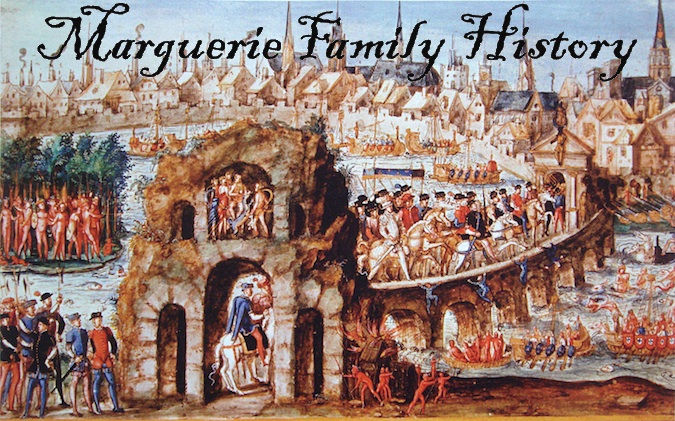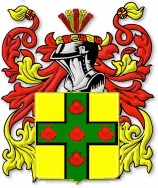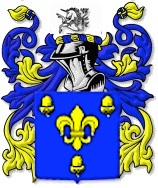 |
|
Our earliest-known ancestor in this line, FRANÇOIS MARGUERIE, was born in 1590 in St Vincent, a part of Rouen, on the River Seine in the north of France. Rouen is the capital of the region of Normandy, and was one of the largest and most prosperous cities of medieval Europe. It was the seat of the Exchequer of Normandy in the Middle Ages, and one of the capitals of the Anglo-Norman dynasties, which ruled both England and large parts of modern France from the 11th to the 15th centuries. Rouen then became one of the Norman cradles of the artistic Renaissance, in particular the one under the patronage of the archbishops and financiers of the town.
But by the time that François was born, Rouen had changed, mainly because of the French Wars of Religion. Rouen was a Catholic City, but on 15 April 1562 the Protestants entered the town hall and ejected the King's personal representative, followed by an outbreak of Iconoclasm (statue smashing). On 10 May the Catholic members of the town council fled Rouen, holing up in the Fort of Saint Catherine which overlooked the town. Both sides resorted to terror tactics.
The Protestant town authorities requested help from Queen Elizabeth I of England, and she sent troops to support the Protestants. On 26 October 1562 French Royalist troops retook Rouen and pillaged it for three days in a very un-Christian fashion.
The war went on for decades. Rouen was attacked on several occasions by Henry IV, but it resisted, notably during the siege of December 1591 to May 1592, with the help of a Spanish army led by the Duke of Parma.
|
Because of the strife in their town (King Henry was assassinated by a Catholic fanatic the year before their first child was born), when François and Marthe had children of their own, they looked to set them up in a new land, with new promise and opportunities (although it would prove to be no less dangerous). Their destination was called "New France." Today we call it Canada. François was a member of the "Compagnie des Marchands de Rouen et de Saint-Malo," formed by Samuel Champlain in 1614 to colonize Québec and corner the American fur trade, and his children would be instrumental in the plan. Their children were:
Marie Marguerie was baptized at St Vincent Cathedral in Rouen, France on 12 September 1620. Her godparents were Nicolas Duchemin and Marie Marguerie. St Vincent's had been completed only a few years before, and featured the finest stained glass windows in the city (the cathedral was destroyed by bombing in World War II but the windows were stored in 1939 and can now be seen in the modernistic Church of Joan of Arc in Rouen).
In 1637, Marie's brother François MARGUERIE had settled at JACQUES HERTEL's trading post at Trois-Rivières (Three Rivers), Québec, located on the north shore of the Saint Lawrence River at the confluence with the Saint-Maurice River. Trois-Rivières had been founded on July 4, 1634, the second permanent settlement in New France, after Québec City. The settlers enclosed the town in a stone palisade as protection from local Algonquin and Abenaki tribes. François and Hertel became close through the course of their interactions in this frontier outpost, and François must have interested Hertel in marrying his 18-year-old sister Marie. François arranged for her to sail from Rouen to New France in the summer of 1639. The passage, made in the late spring, was difficult—one tenth of all passengers en route to New France died on the Atlantic.
After her privileged life in France, the sight of Québec in 1640 must have been a shock to Marie. Trois-Rivières was still a raw untamed place, with only a handful of inhabitants, less than half of them European, including rough French trappers, many living with indigenous wives with mixed children, and a handful of government officials and military officers. To make matters worse, in February 1641 her brother François was captured by Iroquois while hunting. In May over 500 warriors headed toward Trois-Rivières, surrounding the trading post. On 5 June the Iroquois sent François across the Saint Lawrence River to parlay with the commandant of the fort. The inhabitants of the town were flabbergasted to see him; they had given him up for dead. François had to return to captivity until the Governor of New France could come down river from Quebec to negotiate the peace treaty desired by the Iroquois. After his arrival, preliminary negotiations resulted in François being freed as a goodwill gesture.
With life returning to normal (for the frontier, anyway), Jacques Hertel dit Lafresniere (full title) finally signed a contract, notarized by Martial Piraube, to marry Marie Marguerie on 23 Aug 1641. A year later, she and Hertel had a son, who was named François after Marie's brother. Their family grew:
CHILDREN OF MARIE MARGUERIE AND JACQUES HERTEL |
|
Not surprisingly, she turned to a soldier in the "mobile patrol," named QUENTIN MORAL who could provide for and protect her children. Moral was born in a village called St. Quentin in Lorraine, France in about 1620. Always ambitious, he sailed to "New France" (Canada) to make his fortune, but his exact arrival date is unknown (probably around 1645). Between the years 1648-51, he was among forty or so colonists who established homesteads at Trois-Rivières. Quentin was a soldier in the "mobile patrol" in 1651.
Marie was quite a catch on the frontier. Not only had she been raised by a higher class in France, she also inherited land on the island called l'Île de la Trinité from François, which would raise Quentin's status in the town as well. After the Moral-Marguerie marriage, the island was renamed l'Île Saint-Quentin. Marie Marguerie brought three young children to the marriage, aged 3 to 10, along with the land. She bore Quentin four daughters:
CHILDREN OF QUENTIN MORAL AND MARIE MARGUERIE | |
| |
In 1666 the first census was made of New France at the end of July, and Trois-Rivières had a population of 602, Montréal 760 and Québec 2,857, for a total of 4,219 people in Canada. The average age of the habitants of the Trois-Rivières region was approximately 13 years old. (Source: La population du Canada en 1666 by Marcel Trudel and published by Les éditions du Septentrion, Sillery [Québec], PQ, Canada). The Moral household at that point in time consisted of: "Quentin Moral sieur de Saint-Quentin, 44, habitant ; Marie Marguerie, 40, sa femme; Jeanne, 13 ; Marie, 10 ; Gertrude, 8 ; Marthe, 5 ; Robert Henry, 20, et Nicolas Dupuis, 24, domestiques". Marie's daughters by Jacques Hertel had already married and left the house. Trois-Rivieres and adjacent districts had grown in 20 years from a handful of settlers to a village of 69 families and 455 souls. However the town itself still consisted of only about two dozen households and less than a hundred Europeans. (Source: website Alberta Family Histories Society)
Marie Marguerie saw to it that her children received good educations. Her daughters by Quentin were educated at the Ursuline convent established just across the street from the Hertel house. Meanwhile, Quentin adopted the style 'Sieur de St-Quentin' and kept the family income up by selling Marie's inheritance from her first husband to newcomers to the New World. He also served in the military Royal Lieutenant in Canada on 22 Dec. 1650; the Lieutenant civil et criminel du Roi habitant in 1666; and juge prévôt et lieutenenant civil et criminel (provost judge). On 17 Nov 1663, he was appointed royal notary but does not seem to have taken up the office, which was entrusted a year later to Séverin Ameau.
In 1669, Quentin Moral made a concession of 3 arpents of land to Antoine Desrosiers in Trois-Rivières. At the time, Quentin Moral was seigneur of the property, 'L'Arbre-à-la-Croix' in Trois-Rivières.
Quentin Moral died in Trois-Rivières in 1686, but Marie Marguerie outlived him by 14 years, and on the day of her funeral the Recollect priest of the parish of Trois-Rivières, Luc Filastre, eulogized: "Today, November 26, 1700, Marie Marguerie, widow of the late St Quentin was buried. She died fortified by the rites of the Church and with every sign of extraordinary devotion, having lived for more than fifty years in the service of all in this town, their constant helpmate in time of need, showing incomparable charity and zeal, she worked for the Church performing the duties of the sacristy, and caring for the Church appointments incomparably well. She was buried, according to her wish, next to the body of M. Hertel, her first husband."
They are all buried at the Immaculée-Conception-de-la-Sainte-Vierge Cemetery in Trois-Rivières, Mauricie Region, Québec.
GENEALOGY FRANÇOIS MARGUERIE (1590-1645) married MARTHE ROMAIN (1589-1645) and begat... MARIE MARGUERIE (1620-1700), who married QUENTIN MORAL (1622-1686) and begat... MARIE-GERTRUDE MORAL (b. 22 Mar 1658), who married JACQUES JOUIEL (JOYAL) and begat... MARIE JOSEPHE JOUIEL (JOYAL), who married PIERRE ABRAHAM DESMARAIS (b. 1691) and begat... JEAN-BAPTISTE DESMARAIS (15 Nov 1728 - 12 Oct 1807) married MARIE ANGELIQUE ROY (b. 16 Mar 1734) and begat... MARIE JOSEPHE DEMARAIS (b. 1762), who married ROBERT STOTT (20 Feb 1761 - 2 Apr 1836) and begat... MARY STOTT (b. 1783), who married JOSHUA S. MANNING (8 Dec 1782 - 26 Aug 1848) and begat... SARAH AGATHE MANNING (05 Aug 1810 - 19 Jul 1855), who married JULIUS ALBERT RAYMOND (24 Jun 1818 - 21 Feb 1879) and begat... ALBERT JULIUS RAYMOND (1848 - 1924), who married LOIS MATILDA KILBOURNE (1851 - 1937) and begat... FLADELLA RAYMOND (1869 - 1961) who married FRANK HAUSE (1867 - 1951) and begat... CARLISLE HAUSE (1891 - 1972) who married MARJORIE MARCHANT (1892 - 1939) who begat... CARLETON MARCHANT HAUSE, SR. (1917 - 1983) who married JEANNE BRUNNER (1918 - 2000) and begat... CARLETON MARCHANT HAUSE, JR. (b. 1939) who married MARTHA WENK (b. 1940) and begat... JEFF (who married LORI ANN DOTSON), KATHY (who married HAL LARSEN), ERIC (who married MARY MOONSAMMY), and MICHELE HAUSE (who married JOHN SCOTT HOUSTON). |
NOTES
¹—Based on present evidence, 140,000 people in the United States, and many times that number in Canada, are direct matrilineal descendants of Marie Marguerie, the founder of the 'Marie W' haplotype lineage in the Americas. Marie has been identified as one of 262 Filles a Marier or "marriageable girls" who emigrated to New France between 1634 and 1663. They were recruited by religious groups or reputable persons who had to guarantee their good conduct. Most were from rural peasant families. Unlike the later Filles du Roi who emigrated after 1663, the Filles a Marier were not recruited by the state; did not receive a dowry from the King; and were promised nothing but the possibility of a better life. However Marie's story was not that of a typical Filles a Marier, and aside from the date of her migration to Canada, she probably does not fit into this category. Her father was a man of substance, a bourgeoisie, an oar maker and maritime merchant in Rouen. Given the fates of his children, it is likely her father was a member of the Compagnie des Marchands de Rouen et de Saint-Malo, formed by Samuel Champlain in 1614 to colonize Québec and corner the American fur trade. Marie's brother François had already gone to Canada and his exploits were legendary. He was regarded by the First Nations as the European who had most thoroughly learned their language and customs—they called him the 'double man'—he could pass as European or Indigenous. (The Descendants of Marie Marguerie; W3a2 Haplogroup HVR1)
²—Until the late 1900s, church registers in Quebec served as civil and vital records in that province. Throughout the years a second copy of church records, from all denominations, was sent annually to the appropriate courthouse. During the 1940s the vital record collections in courthouses throughout Quebec were filmed by the Institut Généalogique Drouin. The filming of vital records continued for some areas up through the 1960s. Consequently, this filmed set of records became known as the Drouin Collection. The majority of the records in this database cover the time period 1621-1947, as most of the filming was done in the 1940s. The records that were filmed up through the 1960s are also included in this database, although they are very few in number. These records that were filmed later cover the years 1948-1967.
³—Saint-François-du-Lac is a community in the Nicolet-Yamaska Regional County Municipality of Québec, Canada, located at the confluence of the Saint Lawrence and Saint-François rivers, at the edge of Lac Saint-Pierre (Hence its name, "Saint-Francis of the lake"). Historically, the village of Saint-François-du-Lac has been referred to as St-François, St-François-des-Pres, and St-François-Xavier. It was founded as a Jesuit mission village during the colonial years. The community was called St.-François-de-Sales or Odanak. In 1687, construction of Fort Saint-François (or Fort Crevier), a wooden fortified fort, was started as protection against the Iroquois. Between 1689 and 1693, Fort Crevier was raided by the Iroquois and suffered significant damage, having to be rebuilt. Soon Indians from the community, which included refugees from wars with English colonists, participated in many raids, some of them organized and led by French military men, against English colonial settlements in New England in the aftermath of King Philip's War.)
TOP IMAGE: An anonymous painter envisions the royal entry of Henry II in Rouen, on 1 October 1550, modeled on the ancient Roman triumph and specifically compared to Pompey's third triumph of 61 BC at Rome: "No less pleasing and delectable than the third triumph of Pompey... magnificent in riches and abounding in the spoils of foreign nations."
COUSINS, COLLABORATORS & CO-CONSPIRATORS... |
|
|




